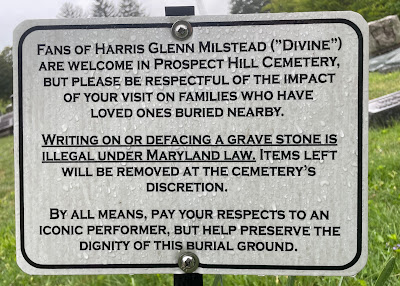No, this is not a Christmas blog, even though I am posting
it as 2023 ends and 2024 begins. Maybe its about seeing into the future. I don’t see the way you do, and you don’t see
the way I do. Does that make either of us wrong? Not only is it healthy to see
things from another’s point of view, but it can also help your creativity.
What other people see
I posted the image above on Instagram and Facebook recently
and had a comment that said, “For all the time I’ve spent there, I’ve never
seen this!”
Even if the person HAD seen the stone, they would never have seen it, or captured its image, that way that I did. The monument is in Laurel hill Cemetery, Philadelphia. It sits atop a small, steep incline, and from the road, it doesn’t look that interesting (you can’t see the words). Remember when you went trick or treating in the suburbs as a kid? Was there a house up a hill that seemed like too much effort for a candy bar, so you skipped it?
I replied to the comment that its interesting how other
people see the same thing differently. It happens to me a lot. Lighting and the
direction you’re facing changes everything! Think about flea markets - you walk
down the aisles in both directions, right? Otherwise, you miss stuff. Some
years ago I found this awesome postmortem photograph in a vintage frame at a
punk rock flea market. Got it for twenty-five bucks! Interesting thing is that
I spotted it on my second trip down that aisle, in the opposite direction.
Once you do find that cemetery treasure during your next jaunt, how do you want to capture it in an image? It is true what Barthes says about a photograph (in his
book, Camera Lucida), that it captures the death of something. So you cannot go
back and capture the same cemetery image someone else did (or even the one I captured myself on an earlier excursion). You’d have to reproduce the angle of entry, composition, lighting,
time of year, and so on. Impossible. But that’s what makes photography art. That's what makes a photograph singular.
PERSPECTIVE
I have often been jealous of images other photographers have
made of the same scenes, same cemetery monuments that I have photographed.
Theirs, at times, seem much better than my captures. But that’s how we learn,
right? Art in general, gives us ideas for how we can improve our own art. And,
it can be painstakingly frustrating at times. I used to photograph cemeteries
with a friend who was easily a foot shorter than me. Just that difference in
elevation provided entirely new perspectives on a given scene.
The easy way to see things differently (and maybe catch
something that you missed before) is to make the extra effort to visit the same
sites again. Park on the opposite side and walk in a direction you’re not used
to. I have visited THE SAME CEMETERIES dozens of times! I typically find
something I missed before.
Cemeteries and their monuments are not static. Stone erodes,
visitors place decorations (or bury things), sometimes there is vandalism. And
everything looks different under a blanket of snow. Shoot at the edges of the
day – a low sun on the horizon throws warmer light and creates long shadows.
AFTER-CAPTURE PROCESSING
Plus, you’re probably not looking to simply document the existence of a gravemarker – you’re probably looking to create some artistic image, right? So go abstract. Use a photo editing ap like Hipstamatic, the one I used to capture the image at top. Perhaps you can try simple black and white, for a more abstract look. Most camera phones will let you change to black and white easily.
 |
| Straight camera phone shot of the same scene (rather boring, right?) |
When I look at this standard, snapshot-style image above, it
doesn’t really do anything for me. The stone is a powerful statement, but
somehow a simple photograph does not project that message, that intent. Barthes
might have said that the viewer should read in this photograph the “distress of
a recent bereavement” (Camera Lucida). How to capture that feeling? A tintype
ap can give this scene a very dated look, as tintypes were around in the
Victorian era when this stone was carved.
 |
| Image edited with Hipstamatic tintype ap. |
You’ll notice that the stone is lit with horizontal sunlight, which casts a shadow from the cross atop the "Crushed Hopes" grave marker. The angled sun also gives definition to the letters. If the face of the stone was lit with direct sunlight, you might not even see the letters.
Use Snapseed (camera phone image editor) or your camera (or
camera phone’s) own photo editing software to create an image you like, one
that successfully captures a mood. There are no rules! You’re not so much altering reality as
creating a more accurate version of what you saw. I guess you might say that I
am not an “incorruptible servant of artistic truth” as classical guitar maestro
Segovia said about the composer Tedesco in 1939!
 |
| "Frozen Warnings," by Ed Snyder |
A few hours before writing this blog, I drove over to Dirty
Frank’s Bar, home of Philadelphia’s Off The Wall gallery. There was a recent
group exhibit of art work, and one of my two pieces that was juried into the
show was sold. I was picking up the unsold piece. I walked in and said hello to
the curator who apologized that my second piece had sold. Hardly a wasted trip!
That second piece you see above. I call it "Frozen Warnings." It is an image layered
with two of my cemetery photographs. I was really happy with the image, and humbled that
a stranger liked it enough to purchase it. "Frozen Warnings" is a composite of two cemetery images, neither of which I was truly happy with. But you know, when you're not happy with something, the end of the story can start today.
Epilogue
Maybe your hopes were crushed in some way last year. Artistically, perhaps you hit a wall. Horror author Grady Hendrix wrote, “Christmas is a time to
be haunted by our memories, for every Christmas is our first Christmas without.”
(This is from his 2023 article, How the Holidays Became Haunted, https://www.tor.com).
Hendrix was talking about loved ones lost, but maybe we can
think of it as old habits lost? A few
years ago I spent back to back New Years Days (two successive years) exploring
an abandoned cemetery. Since then, I’ve developed arthritis in my hip so I
think my days of jumping off walls into abandoned cemeteries are over. But if
you stay creative, and are open to new ideas, there will always be new worlds to
explore. The soul wants adventure.
And then there is luck, right? A red fox appears out of
nowhere and poses in front of a tombstone. A parade of Harleys pours into the
cemetery for a biker funeral. As they say in the Hunger Games stories, may the
odds ever be in your favor.
























_small.jpg)

























